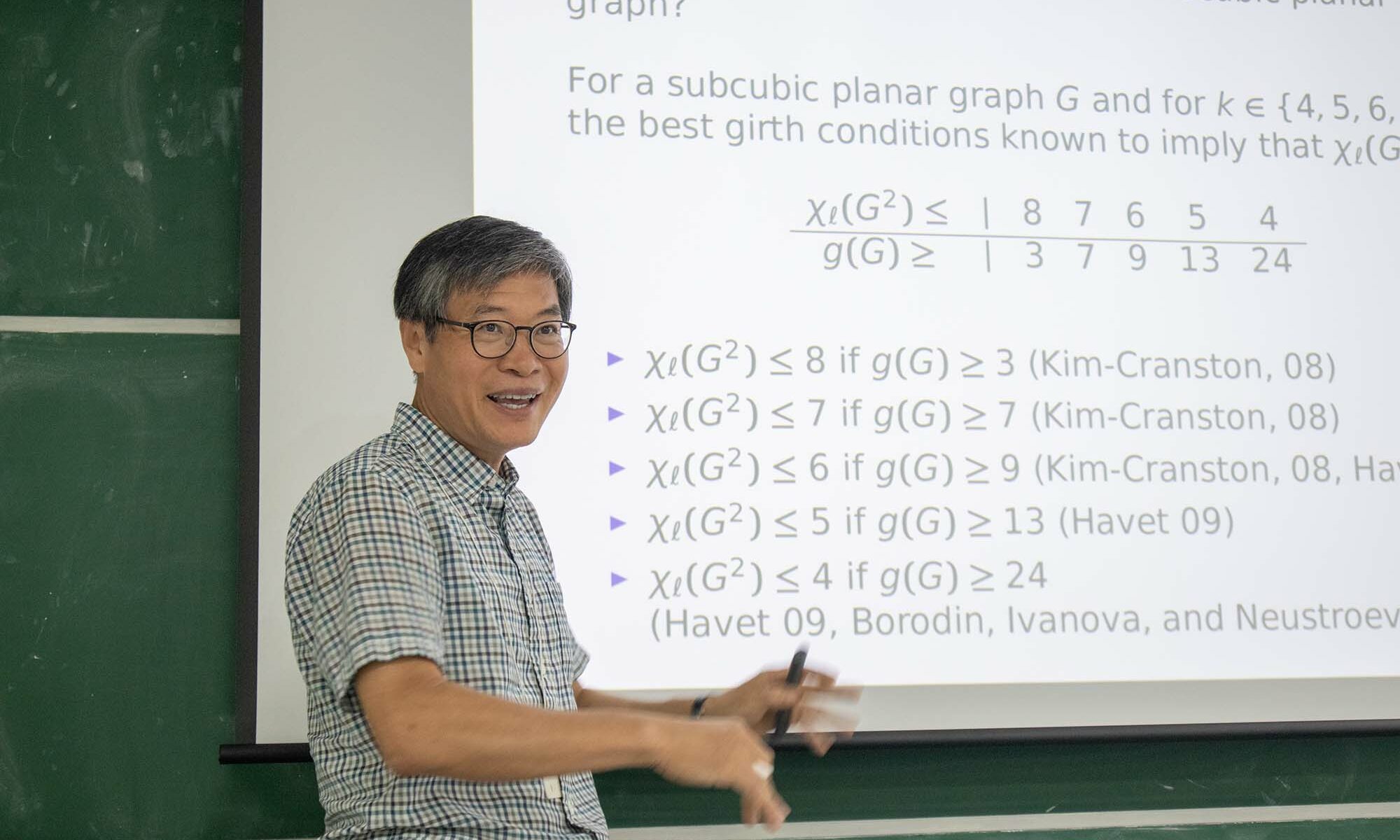On September 12, 2023, Seog-Jin Kim (김석진) from Konkuk University gave a talk at the Discrete Math Seminar on the list chromatic number of the square of subcubic planar graphs of girth at least 6. The title of his talk was “The square of every subcubic planar graph of girth at least 6 is 7-choosable“.
Seog-Jin Kim (김석진), The square of every subcubic planar graph of girth at least 6 is 7-choosable
The square of a graph $G$, denoted $G^2$, has the same vertex set as $G$ and has an edge between two vertices if the distance between them in $G$ is at most $2$. Wegner’s conjecture (1977) states that for a planar graph $G$, the chromatic number $\chi(G^2)$ of $G^2$ is at most 7 if $\Delta(G) = 3$, at most $\Delta(G)+5$ if $4 \leq \Delta(G) \leq 7$, and at most $\lfloor \frac{3 \Delta(G)}{2} \rfloor$ if $\Delta(G) \geq 8$. Wegner’s conjecture is still wide open. The only case for which we know tight bound is when $\Delta(G) = 3$. Thomassen (2018) showed that $\chi(G^2) \leq 7$ if $G$ is a planar graph with $\Delta(G) = 3$, which implies that Wegner’s conjecture is true for $\Delta(G) = 3$. A natural question is whether $\chi_{\ell}(G^2) \leq 7$ or not if $G$ is a subcubic planar graph, where $\chi_{\ell}(G^2)$ is the list chromatic number of $G^2$. Cranston and Kim (2008) showed that $\chi_{\ell}(G^2) \leq 7$ if $G$ is a subcubic planar graph of girth at least 7. We prove that $\chi_{\ell}(G^2) \leq 7$ if $G$ is a subcubic planar graph of girth at least 6. This is joint work with Xiaopan Lian (Nankai University).
Seog-jin Kim (김석진) gave a talk on the Online DP-coloring of graphs at the Discrete Math Seminar
On July 7, 2020, Seog-jin Kim (김석진) from Konkuk University presented his work on the online DP-coloring of graphs, a common generalization of the online coloring and the DP coloring, both generalizing the list coloring of graphs. The title of his talk was “Online DP-coloring of graphs“. He will stay at the IBS discrete mathematics group until the end of this week.
Seog-Jin Kim (김석진), Online DP-coloring of graphs
Online list coloring and DP-coloring are generalizations of list coloring that attracted considerable attention recently. Each of the paint number, $\chi_P(G)$, (the minimum number of colors needed for an online coloring of $G$) and the DP-chromatic number, $\chi_{DP}(G)$, (the minimum number of colors needed for a DP-coloring of $G$) is at least the list chromatic number, $\chi_\ell(G)$, of $G$ and can be much larger. On the other hand, each of them has a number of useful properties.
We introduce a common generalization, online DP-coloring, of online list coloring and DP-coloring and to study its properties. This is joint work with Alexandr Kostochka, Xuer Li, and Xuding Zhu.
Seog-Jin Kim presented his work on signed colouring and list colouring of k-chromatic graphs on January 28
Seog-Jin Kim from Konkuk University presented a talk at Discrete Math Seminar on January 28, 2019. The title of his talk was “Signed colouring and list colouring of k-chromatic graphs.”
Seog-Jin Kim (김석진), Signed colouring and list colouring of k-chromatic graphs
A signed graph is a pair (G, σ), where G is a graph and σ: E(G) → {1,-1} is a signature of G. A set S of integers is symmetric if I∈S implies that -i∈S. A k-colouring of (G,σ) is a mapping f:V(G) → Nk such that for each edge e=uv, f(x)≠σ(e) f(y), where Nk is a symmetric integer set of size k. We define the signed chromatic number of a graph G to be the minimum integer k such that for any signature σ of G, (G, σ) has a k-colouring.
Let f(n,k) be the maximum signed chromatic number of an n-vertex k-chromatic graph. This paper determines the value of f(n,k) for all positive integers n ≥ k. Then we study list colouring of signed graphs. A list assignment L of G is called symmetric if L(v) is a symmetric integer set for each vertex v. The weak signed choice number ch±w(G) of a graph G is defined to be the minimum integer k such that for any symmetric k-list assignment L of G, for any signature σ on G, there is a proper L-colouring of (G, σ). We prove that the difference ch±w(G)-χ±(G) can be arbitrarily large. On the other hand, ch±w(G) is bounded from above by twice the list vertex arboricity of G. Using this result, we prove that ch±w(K2⋆n)= χ±(K2⋆n) = ⌈2n/3⌉ + ⌊2n/3⌋. This is joint work with Ringi Kim and Xuding Zhu.




